Luminescence properties and the thermal quenching mechanism of Mn2+ doped Zn2GeO4 long persistent phosphors
Abstract
Cation doped Zn2GeO4 materials have been intensively explored owing to their excellent performance in photocatalysts, optoelectronic devices and white light-emitting diodes. However, the luminescence process and thermal quenching arising during the optical excitation of these materials are yet to be clarified. The pure and 2% Mn2+ doped Zn2GeO4 phosphors were prepared via the high temperature solid state reaction. The phosphors were characterized by X-ray diffraction, ultraviolet-visible diffuse reflectance spectroscopy, photoluminescence spectroscopy, X-ray photoelectron spectroscopy and afterglow decay curves. The thermal stability and quenching of Mn2+ luminescence were explained by the temperature dependence of photoluminescence spectroscopy and the configuration coordinate diagram. The thermal quenching of Mn2+ luminescence is mainly due to the delocalization of excited electrons from the excited state to the ionized state. Two kinds of origination of the O 1s peak were revealed by X-ray photoelectron spectroscopy. A model is constructed to interpret all the photoluminescence and long persistent luminescence of the Mn2+ doped Zn2GeO4. This may contribute to the understanding and optimization of luminescence properties for other Mn2+ doped inorganic phosphors.



 Please wait while we load your content...
Please wait while we load your content...